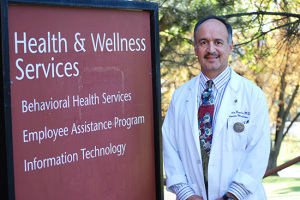By Linda Weiford, WSU News
 PULLMAN, WASH. – As Ebola continues to make headlines and warm autumn weather dominates much of the Northwest, flu isn’t on most people’s radar. But it should be.
PULLMAN, WASH. – As Ebola continues to make headlines and warm autumn weather dominates much of the Northwest, flu isn’t on most people’s radar. But it should be.
Influenza has arrived early to pockets of the region, with Washington, Oregon and Idaho reporting sporadic viral activity. At Washington State University, doctors at the Health and Wellness clinic diagnosed the first flu case on Sept. 28. Since then, they’ve diagnosed 30 more, said Dennis Garcia, senior associate medical director.
And it’s not even Halloween yet.

“Usually we don’t start seeing cases until December or January,” said Garcia. “But it’s here … now.”
In fact, this marks one of the earlier influenza arrivals he has encountered during his 18 years practicing at WSU, he said. The earliest arrived in late August 2009, the year of the novel H1N1 “swine flu” that sickened 60 million Americans and killed 12,000 more, according to the U.S. Centers for Disease Prevention and Control.
So far this season, H1N1 is circulating on a small scale, according to the CDC, with strains Type A-H3 and Type B dominant. Most cases diagnosed at WSU have been Type A, said Garcia.
Symptoms of a scratchy throat, headache and achy eyes, cough and fever of 101-102 are forcing students to miss a week or so of classes, he said.
“When students hear their diagnosis, they say, ‘Really? I have the flu?’ Overall, they seem pretty surprised,” he said.
That’s because most people associate flu with winter, he said, and not with the warm, sun-shiny weather we’ve been experiencing through much of autumn.
Erratic old foe
“Generally speaking, I’d say that yes, flu has arrived early where you are,” said epidemiologist Matthew Biggerstaff of the CDC’s influenza division.
An early flu season doesn’t necessarily mean it will be a bad flu season, he said: “It’s very difficult to predict.” The CDC monitors influenza-related reports of doctor visits, hospitalizations and deaths, he said, and sometimes those reports trickle in before precise figures are known.
But here’s what is known, he said: once the flu hits, it can unfold in various ways. It may hopscotch over some areas while dwelling in others; cause fierce symptoms one year and mild the next; target young and middle-age adults one season and children and seniors another.
“You’ve seen one flu season, you’ve seen one flu season – that’s the motto we use,” said Biggerstaff.
Wash hands, get a shot
Because it is airborne, influenza spreads more easily among groups in close contact. So college campuses can become mixing bowls for the virus, said WSU’s Garcia.
What’s more, “many students don’t get enough sleep, they skip meals and they’re on the run. That leaves them vulnerable,” he said.
 Since the best way to combat influenza is with vaccines, Garcia said he hopes early arrival of the virus will spur students and employees to get their shots at clinics held the next two Fridays in October at Health and Wellness. (See https://archive.news.wsu.edu/2014/10/16/employees-can-get-flu-shots-quit-smoking-via-wellcoug/#.VEZ6wk10yfB)
Since the best way to combat influenza is with vaccines, Garcia said he hopes early arrival of the virus will spur students and employees to get their shots at clinics held the next two Fridays in October at Health and Wellness. (See https://archive.news.wsu.edu/2014/10/16/employees-can-get-flu-shots-quit-smoking-via-wellcoug/#.VEZ6wk10yfB)
The 2014-15 vaccine protects against H1N1 and other circulating flu viruses. It takes about two weeks for a person to develop full immunity, he said: “As long as people get flu shots, it’s a threat we can control.”
Contacts:
Dennis Garcia, WSU Health & Wellness Services, djgar@wsu.edu
Linda Weiford, WSU News, 509-335-7209, linda.weiford@wsu.edu